As per my previous post, I arrived at my destination Park last night. I spent today exploring Golden Gate Highlands National Park, located near the town of Bethlehem and on the northern edge of the embedded country of Lesotho. Golden Gate NP (130 sq mi), established in 1963 to protect the sandstone shelters that once served as shelters for the indigenous San people (a.k.a. “Bushman”), lies in the rolling foothills on the northern end of the Maluti-Drakensberg Mountains. The landscape consists mainly of wooded ravines, gullies and highland grasslands (or grassland veld as they call it). The park’s most notable features are its golden, ochre, and orange-hued, deeply eroded sandstone cliffs and outcrops that shine golden-yellow in the setting sun, from which the Park derives its name. I did my best to capture this scene in the following photos:
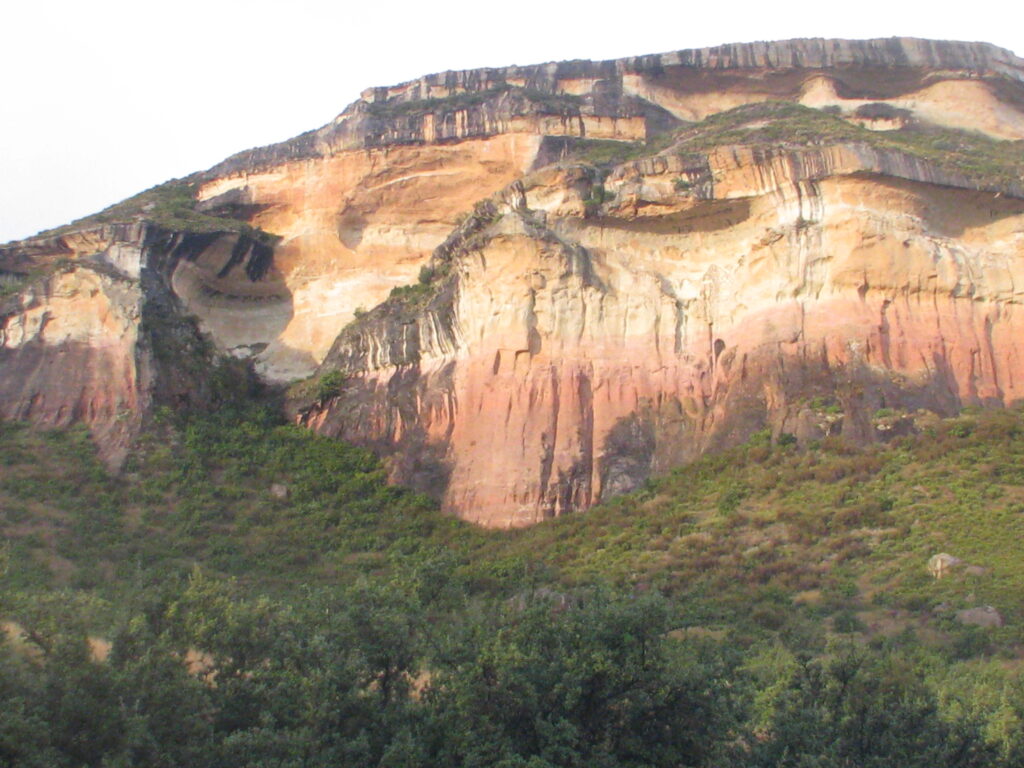
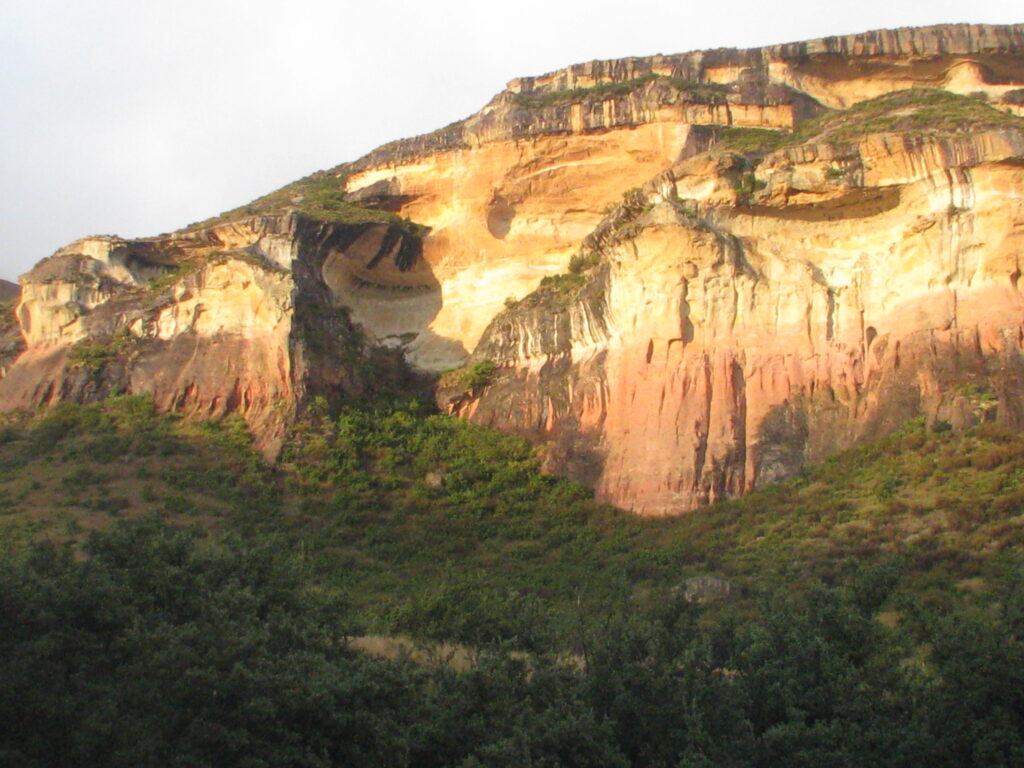


Although the rock cliffs and outcrops are the flagship features of the Park, the Park is actually most important for its conservation of high elevation grassland veld. As this series of photos depict, the mountains and valleys are covered by grassland, with something like 40 different grass species making up the mix. It is truly remarkable to see grasslands extend from the valley bottom up over the tallest mountains, some of which climb over 10,000 ft in elevation.
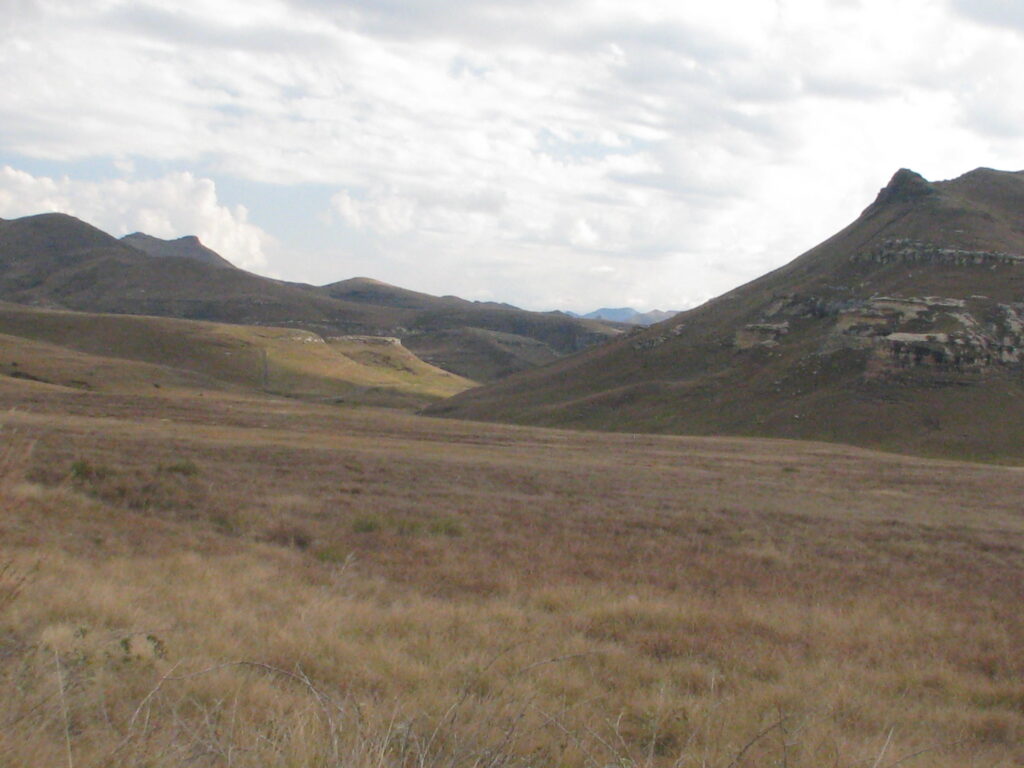
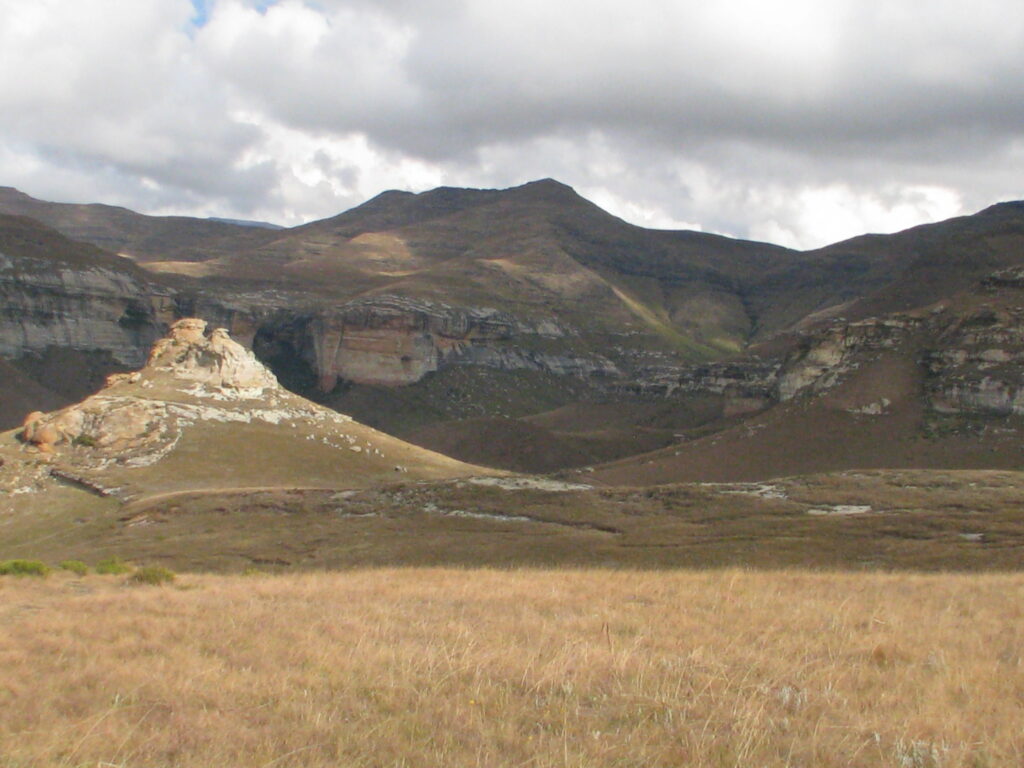
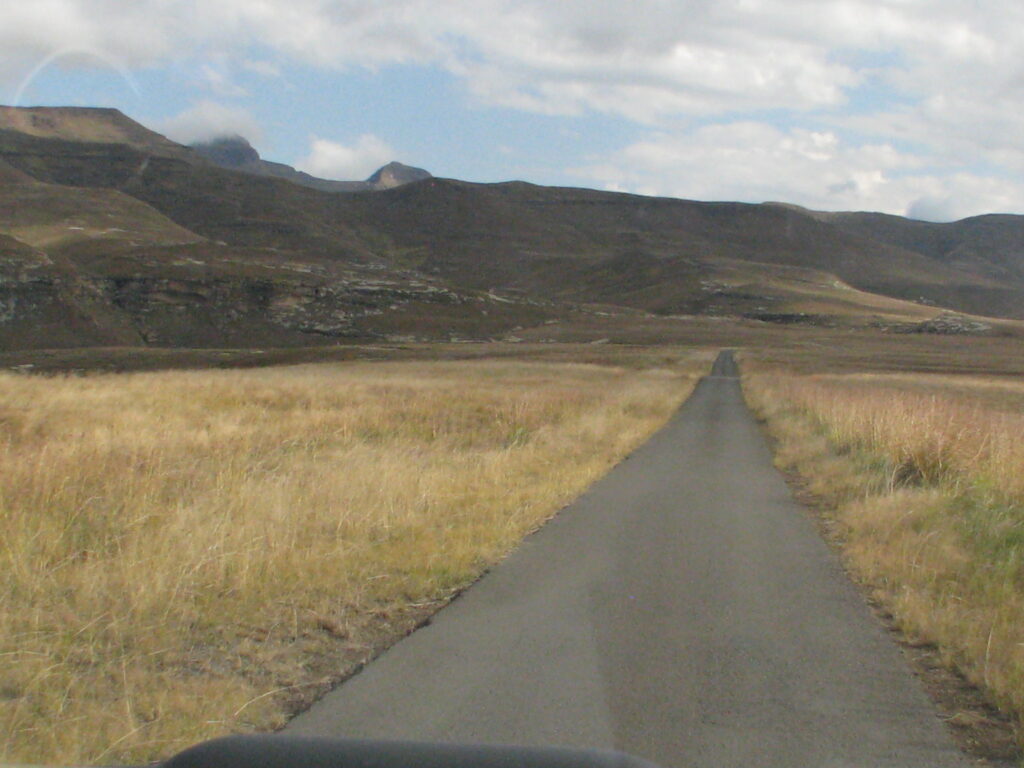
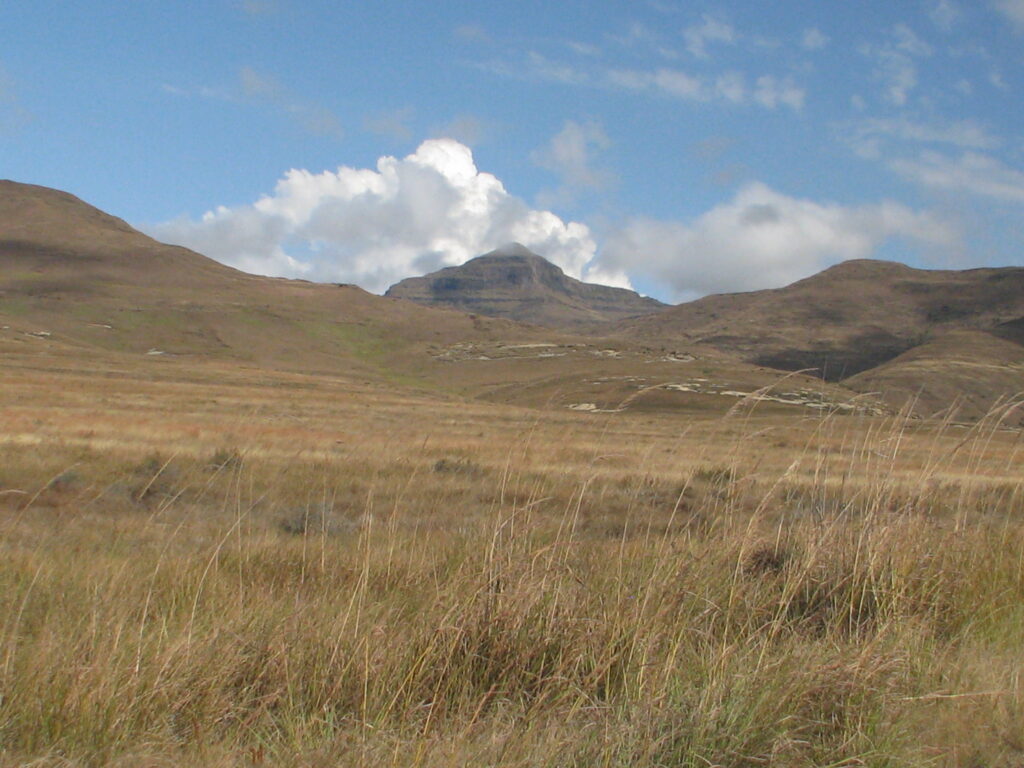
Another notable feature of the Park is the numerous caves and shelters displaying San rock paintings, which I was not able to see. The San were popularized, you might recall, in the movie “The Gods Must be Crazy”. The San are part of a larger ethnic group of herders (Khoi) and hunter-gatherers (San) in southern Africa known as Khoisan, which as recently as 22,000 years ago apparently constituted the largest group of humans on earth. Unfortunately, like most indigenous groups in Africa and elsewhere, the Khoisan were dispossesed of land and gradually displaced and/or assimilated by more “advanced” cultures – in this case, first by the southward immigration of Bantu-speaking agriculturalists around 2,000 years ago, and eventually by European colonists, primarily Dutch (known as the Boers) beginning in the mid 17th century and finally the British who took over from the Dutch in the early 19th century after a bloody war (known as the Boer war). As with many indigenous peoples, small pox decimated the Khoisan and Bantu after contact with European colonists, and many local populations were exterminated or enslaved by the technologically more advanced European colonists. Interestingly, following the end of Apartheid in 1994, the term “Khoisan” has gradually come to be used as a self-designation by ethnic South Africans as representing the “first nations” of South Africa vis-a-vis the ruling Bantu majority, and there has been an uprising of “Khoisan activism” in recent years, with ardent calls to restore ancestral land claims. I wish them the best of luck in their uphill endeavor.
The Park is also notable as one of the last refuges in all of Africa of the rare bearded vulture (also known as the lammergeier and ossifrage) and the southern bald ibis, as well as the rare oribi (a small, slender species of antelope). Alas, I did not see any of these species today despite my efforts, but these was not surprising given how rare they are and the time of year – regardless, it’s nice to know they are here. I just have to show you a picture of the head of the bearded vulture that I borrowed from the internet – so cool:
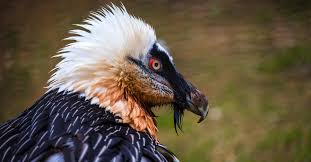
My public campsite is Glen Reenen rest camp in the Park. It’s a pretty awesome setting as I hope these photos capture:
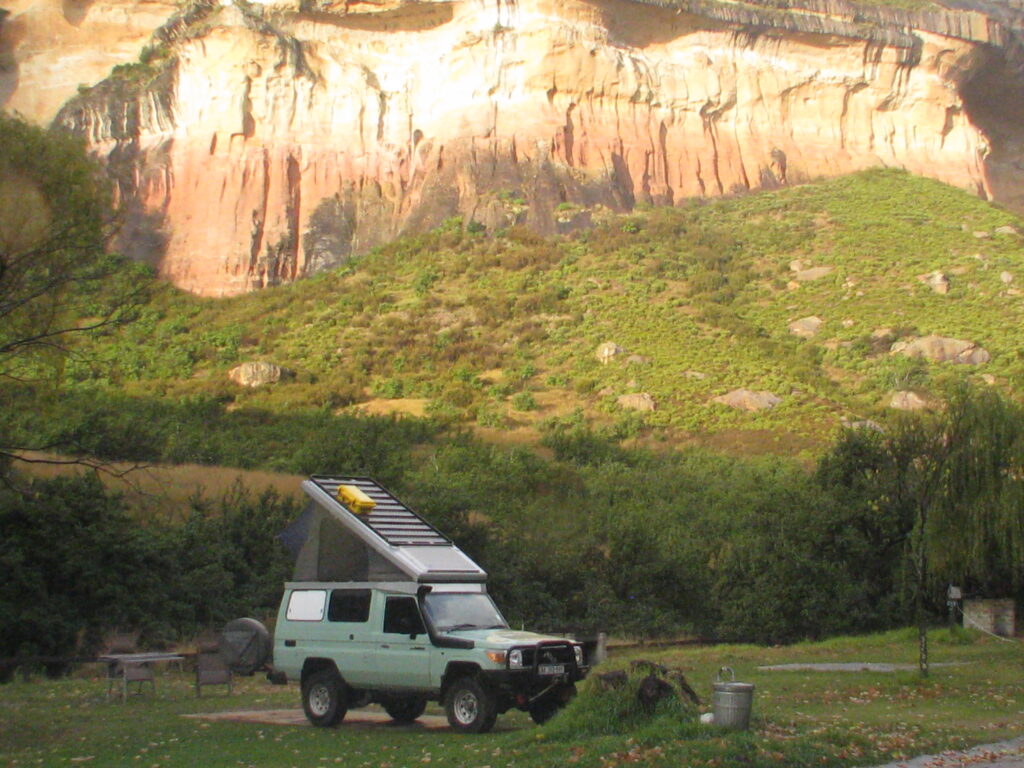
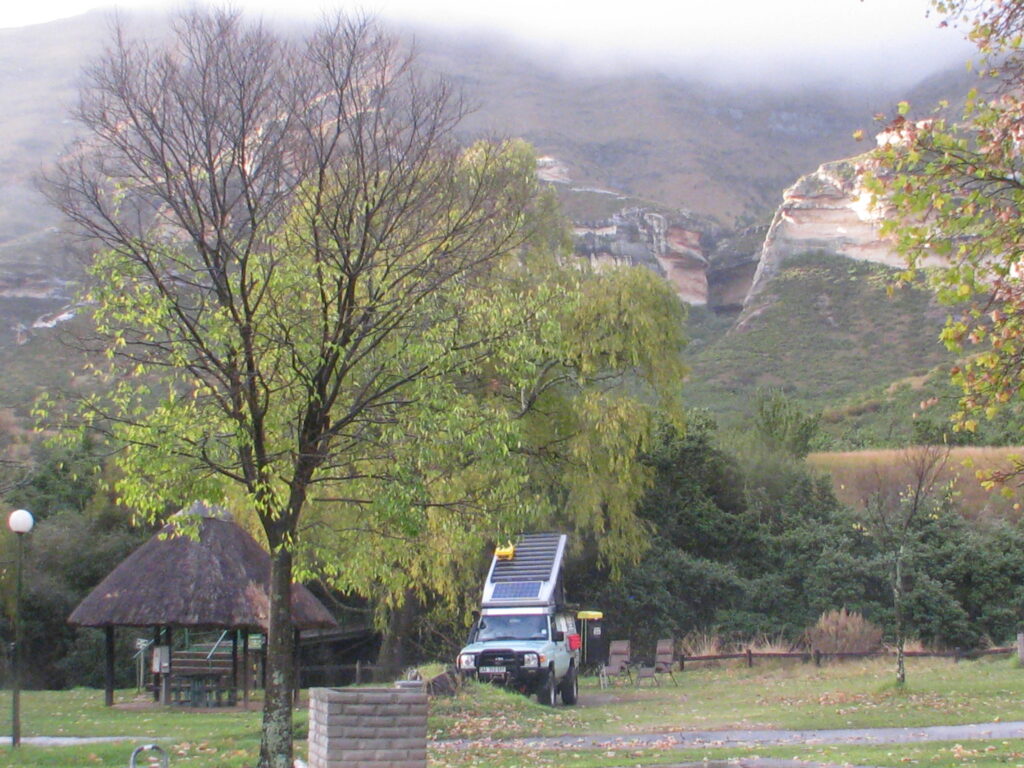
I know this post is getting long, but I have to share some details and photos of the 4 hour hike I did this morning becuase it was challenging and rewarding on many levels. Basically I climbed 3,000 ft up above the escarpment to the high ridge above the campsite and then traversed the ridge for a couple of miles and then descended to below the escarpment and traverse the base of it back to the beginning. I started in beautiful sunny weather with a few broken clouds but by the time I got above the escarpment the wind was howling and I was engulfed in rain clouds. Visibility was very poor at times, but then it would break a little and I would get spectacular views only to be socked in again a minute later. I was the only person on the trail – sublime! Here are some shots of the hike that make it look more tame than it actually was – honest. Note, the first picture shows the central part of the ridge I traversed way up above the campsite:


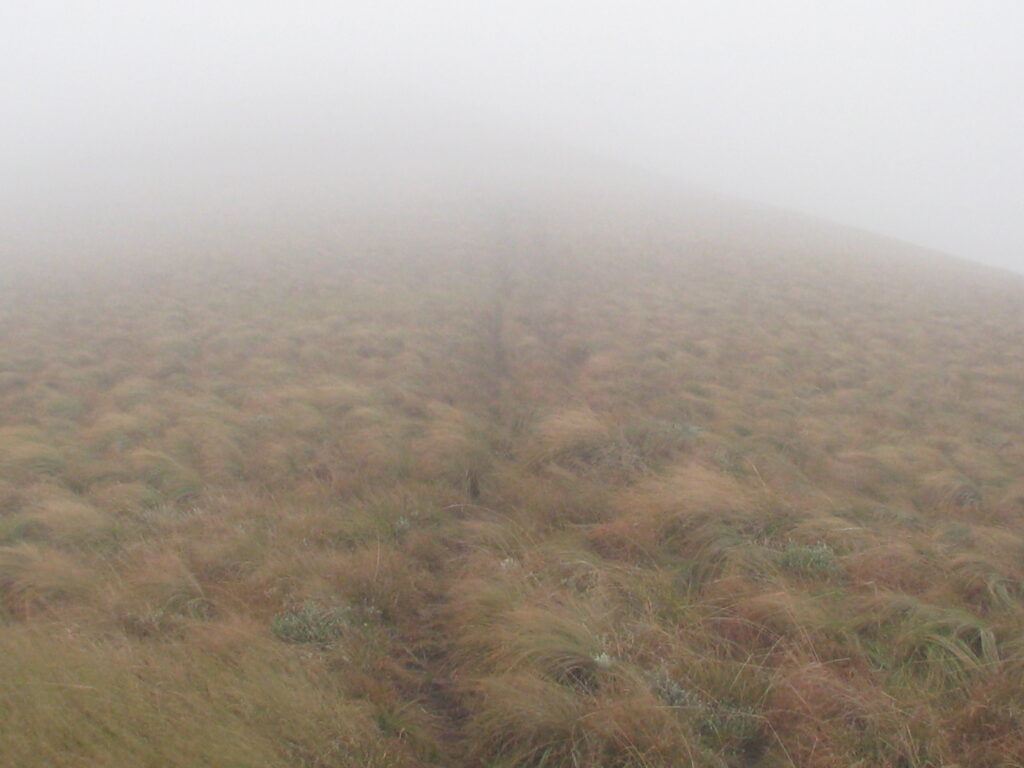
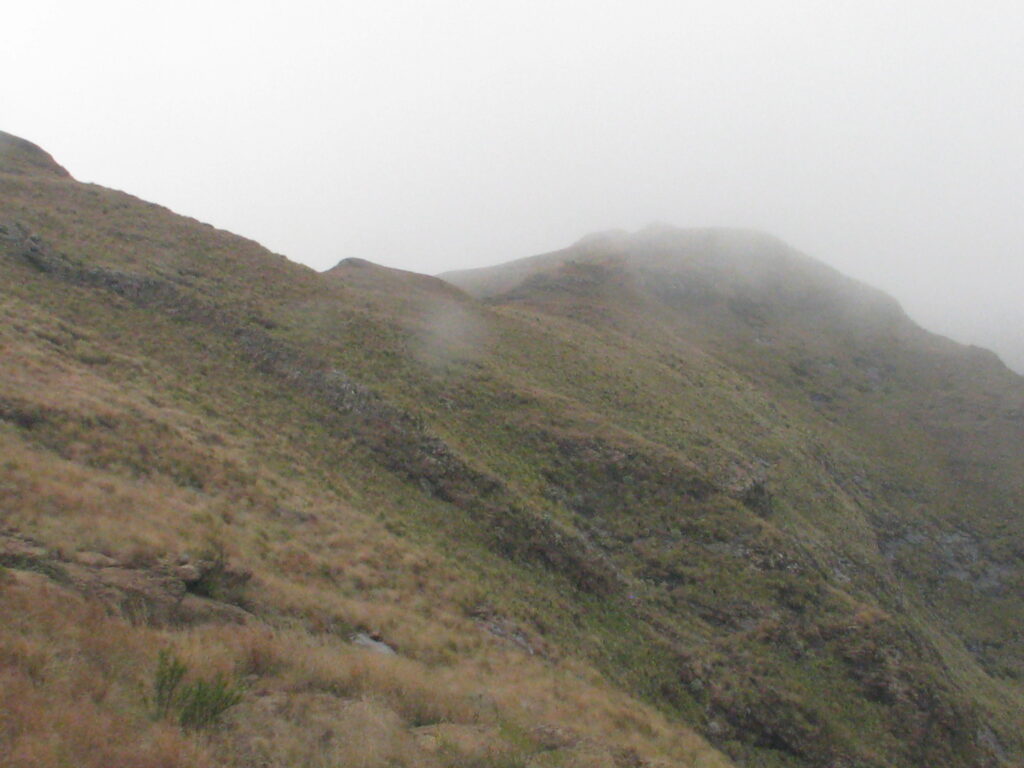
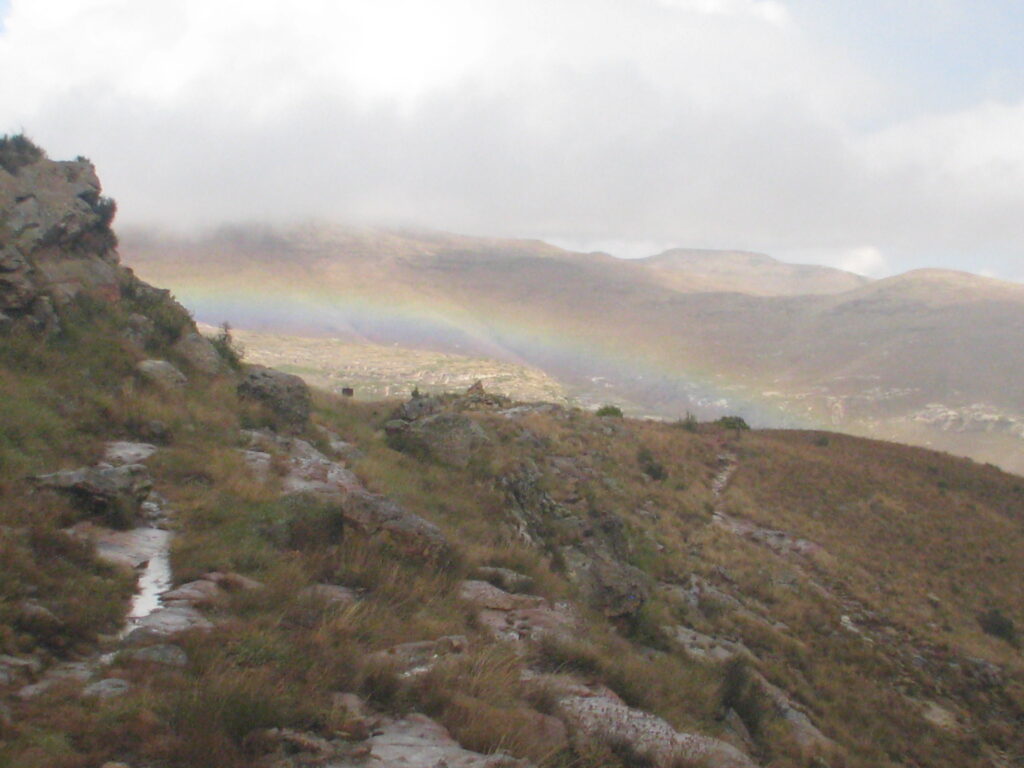
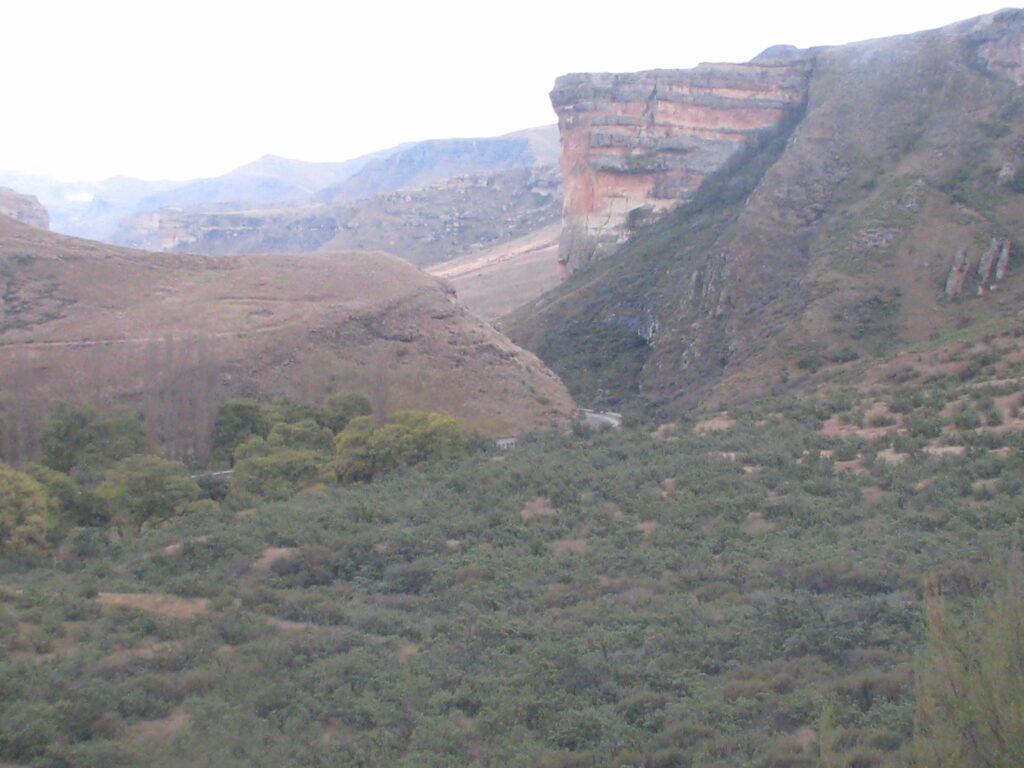
OK, enough is enough, it’s time for, you guessed it, species of the day. Today I am dedicating this choice to my granddaughter Skylar, and she will know why is just a second. The species is the Chacma Baboon, which most will be somewhat familiar with. While these guys can be a real nuisance around the campsite – stealing anything not tied down or that weighs less than about 50 pounds, edible or not – they have a remarkable social structure. They usually live in troops that vary is size, but usually have dozens of individuals, including a dominant male, several subordinate males, lots of females and young ones. And it is to this last item that I bring your attention Skylar. The picture below is of a mommy and baby! Indeed, this little guy couldn’t be more than a few days old. Mom was so intent on letting her little baby nurse that she wouldn’t even move off the road, forcing me and other vehicles to skirt around her. Now that’s a nurturing mommy!
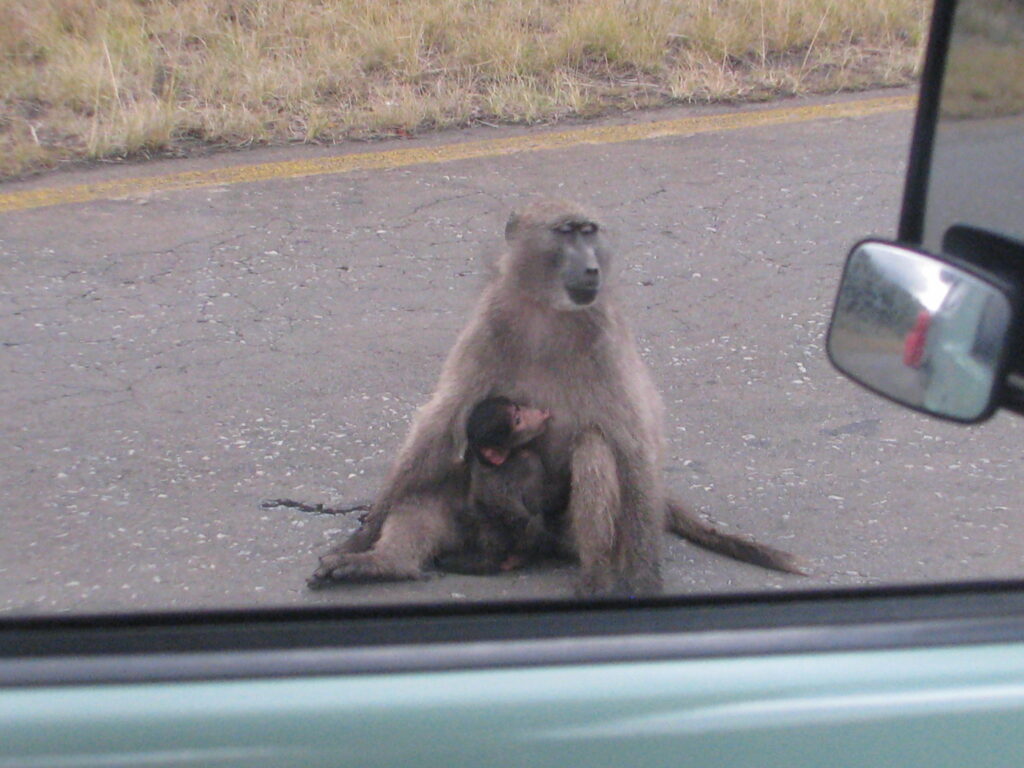
Hope you liked that one Skylar. Tomorrow, on the road again. Cheers.

Exquisite country and hoorah for “doting mommas”!!!
Hey sweetie I hope you are doing OK, or better! Cheers.
Kev, I love it!! Can you share some photos/stories from your campsites and what you are eating and how you are cooking , sleeping, etc… I love all the other more educational stuff, but am also very curious about your day to day existence and the boring stuff too. Thanks bro!! Keep on truckin!
Hey bro. OK, you asked for it. Will try to add some of that dull practical stuff in the mix, but not too much as don’t want to lose people’s interest. You and Nancy might be the only ones interested in that stuff???? Cheers and wish you were along for the ride.
Wow! Just Wow! Amazing pictures and all to yourself! ❤️
Just the way I like it when I am in nature!
Hi Kevin, Thanks for taking your friends and family along on this amazing trip. I am enjoying the views and the narrative! What a gorgeous landscape there in Golden Gate Highlands. I love the cliffs and the grasslands. Looking forward to the next installment. All best wishes on your travels, Sandy
Thanks Sandra and so glad you are along for the ride. Hope you and Abe are well. Nancy keeps me informed! Cheers.
Is it just me, you look like you are all alone at all the campsites. Are the any other people around?
Hey sis. Well, sometimes yes, sometimes no. I have had a couple of non-Park campsites to myself, including the one I am in right now, but the National Park campsites have had others. Last couple of night I think there were two other parties in the campground, but none right next to me – sweet. Love ya.
Love this Kevin. What a great hike, which is rare to find in many parts of Africa, especially inside parks due to the potential for human wildlife conflicts (aka. you getting eaten or trampled). The baboon troops are amazing to watch even if a big threat to your campsites (which is a big advantage of having all your stuff fit inside the vehicle when you are away from camp). Also, the young baboon infant is likely several weeks old as you can find them much smaller and less hairy than that one (they are up to. 2 lbs though when born). Love the dedication to Skylar. Safari Njema.
Thanks for clarification mook on the age of the baby baboon. Of course I was just guessing! Yes, hiking in the parks has been great as I know it won’t last. In fact, probably took my last unguided hike!
I would like to hear the other stuff too, so I guess that makes 3 of us. Do you ever get nervous out there by yourself? Do the animals ever get aggressive towards you.
Love the pictures . Some beautiful spots. Be safe my brother er r.
Love you Joan
OK, will try to add some (but not too much) of the boring practical day-to-day living stuff. No, I don’t get nervous by myself in nature and animals are never aggressive unless you give them cause, which I don’t. Will be safe, no worries! Love ya.
Just gorgeous scenery and informative. Thanks, Joan
Love the cliffs! I also like the boring day to day stuff, but agree- not too much of it. Thanks for sharing
OK, thanks. Will try to reach a delicate balance but my audience is very broad so a bit challenging.
That hikes sounds awesome! Wish I was there to explore those highlands and cliffs look so cool ❤️
Yes, you would have loved the hikes!
Another terrific account. Love the subject of the Khoisan, and yes, we watched “The Gods Must Be Crazy” years ago. Enjoyed books on them by Laurens van der Post (e.g., A Story Like The Wind) and “The Harmless People” by Elizabeth Marshall Thomas. Also am so impressed by the Bearded Vulture.